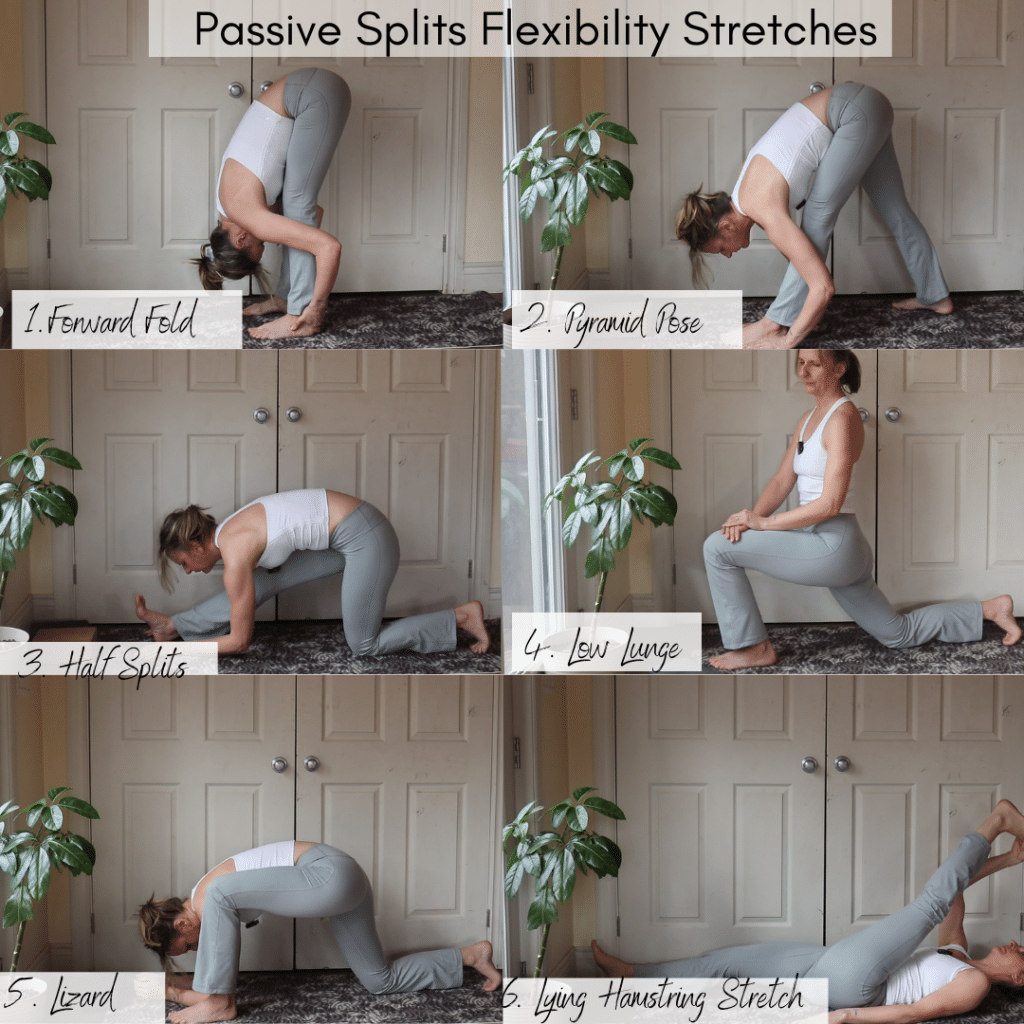There are many ways to stretch for the splits. In fact, over the last year and a half, I have followed all kinds of different routines that helped me get closer to those splits. Today, I will share one of my favorite 15-minute split stretch videos AND give you my best tips as you learn how to increase your flexibility for the splits.
How to Increase Your Flexibility for the Splits
I have learned to do the splits in my forties with absolutely no prior background. I wasn’t particularly flexible and had never done the splits before, even as a child. The learning process is still fresh in my mind as I close that gap (I can sit in the splits position for about 10 seconds, but I am working on holding it longer). UPDATE: I have strong splits now and created a few more routines you may want to check out:
- 8 Stretches to Unlock Your Front and Middle Splits Flexibility
- Active Splits Stretching: Refine Your Front Splits
- Learning the Splits Over 40: Can Anyone Learn the Splits?
Moreover, I discovered there was a universe of interesting yoga poses that I wanted to achieve that required flexibility training. That’s why, after focusing on the front splits for a year, I created a full-body flexibility training program that doesn’t leave anything out.
My Ultimate Whole Body Flexibility Program is like nothing you have ever seen. You will train to achieve the splits, the wheel, king pigeon, king dancer, and the standing splits in a way that respects your abilities yet guarantees results.
The three-stage process is accessible for beginners yet challenging for more advanced ones.

Muscles to Stretch to Get Your Splits
Now, let’s discuss some questions you may have as you work on increasing your flexibility for the splits. For example, what muscles do you need to stretch? Your hamstrings will require the most work. You must also stretch your hip flexors, glutes, and inner thighs.
Your Hamstrings
Did you know your hamstrings include three main muscles that go all the way down to your shin bone? I had no idea, but as you close the gap for your splits, you will feel that, believe me!
Your hamstring muscles include the biceps femoris, the semimembranosus, and the semitendinosus muscles.

How Long to Hold Your Stretches
Generally speaking, you should hold a stretch until it no longer feels uncomfortable (usually between 30 and 60 seconds). However, when you train for the splits, you can get deeper in almost any stretch as you open up. That’s why I like to hold most stretches for about a minute or two.
Passive Vs. Active Stretches
Passive stretching simply lets gravity stretch your muscles as you sit in a specific pose. On the other hand, active stretching requires you to move from one pose to another and contract your muscles.
Many instructors advise you to work on your splits flexibility with active stretches. I sometimes include active stretches in my training, but I found that passive stretches give me the most results.
Splits Passive Stretches Examples
Here are some common splits passive stretches examples:
- Forward Fold
- Pyramid Pose
- Half Splits
- Low Lunge
- Lying or Wall Hamstring Strech
- Lizard Pose

Splits Active Stretches Examples
You can often use a passive stretch with a dumbbell and move up and down into the pose to make your stretches active. Another option is to move from one stretch to another. Here are some examples:
- Active Half Splits
- Active Foward Fold
- Skandasana
- Active Pyramid
- Active Yogi Squats
- Goddess Pose

Will Working on Your Mobility Improve Your Splits
Your mobility is your ability to move actively through the whole range of motion of each pose. That is accomplished through active stretching. Good mobility requires flexibility, strength, and endurance. That’s why the Asana Practice in my Full-Body Flexibility Program includes mobility exercises and my phase 1 videos as well. Moreover, I recommend strength and endurance workouts (my program includes five short workouts). That being said, I still favor static stretches.
Read Why You Don’t Need to Be Gumby: Mobility vs. Flexibility to learn more about mobility.
Can You Do the Splits In Thirty Days?
Absolutely not! I can’t believe how many programs are marketed to lead you to believe you will achieve the splits in 30 days! It took me three months to get from phase 1 to phase 2 (see the phases in my program), and I have been working between phase 2 and phase 3 for ten months.

How Often You Should Train to Improve Your Flexibility for the Splits
Daily! Fifteen minutes a day will do wonders! I recommend you go to a quiet room, listen to some great music, and make this fun! You will look forward to your flexibility training sessions. Once you reach phases 2 and 3, 30 minutes a day is even better, but don’t let that scare you! I regularly cut my sessions short. Anything is better than nothing. It’s all about the journey, not just the destination. As you make your flexibility exercises part of your daily routine, you grow, learn, and change. Flexibility is not just about the body, it’s about the mind also.
15-Minute Splits Stretch Video




